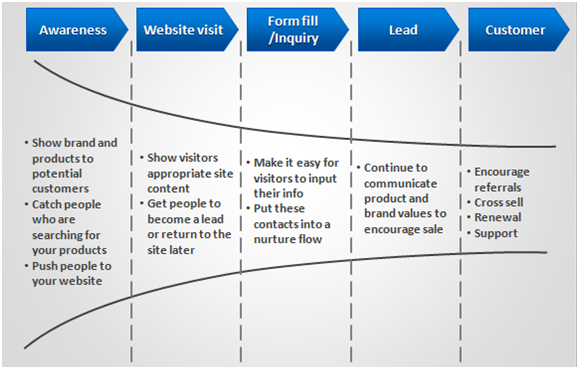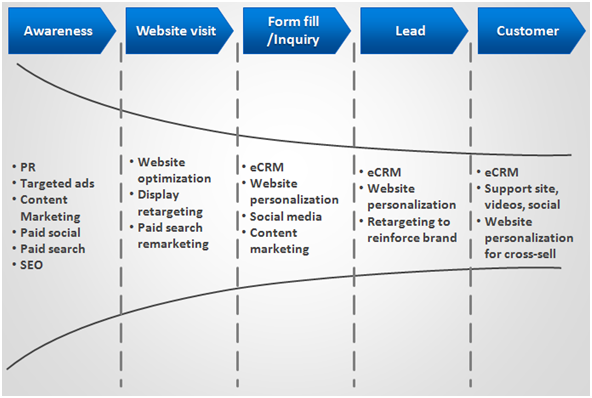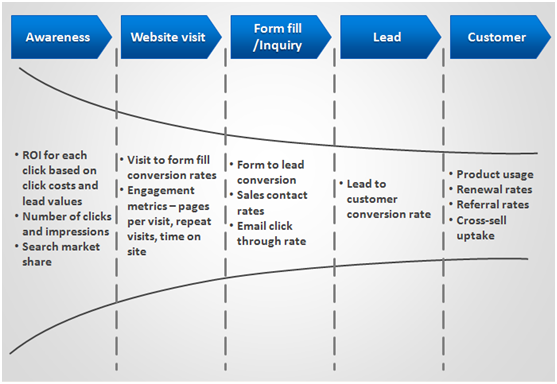It’s often useful to take a step back in order to analyze your current marketing situation. One technique I find very useful for doing this is visualizing a marketing and sales funnel, examining this from a few different angles and using this to spot where digital marketing campaigns and optimization can be implemented for most effect.
Below I’ve created a simple funnel which looks at a few stages in a typical customers’ journey. The ‘awareness’ stage represents someone who doesn’t know about your company or may not even be aware of your product. ‘Website visit’ represents the people on your website or the people who have visited but left without leaving their contact details. ‘Form fill/inquiry’ refers to the people who have given you their details on the site and ‘lead ‘ is when these people have been qualified and sent to sales.
I have then examined this funnel from 3 different digital marketing angles, starting with the objectives for each stage, the appropriate channels, and the success metrics.
Objectives
Digital marketing has a part to play from the time your prospective customer has no idea that your company exists through to them being a regular customer. This first funnel looks simply at the things that digital marketing could achieve at each step of the journey.

Channels
You then need to look at the channels that could support each of the above objectives. In the early stages most companies will need to rely on paid media like Google Adwords and programmatic advertising targeted at certain demographics, job roles or interests.
As you move down the funnel you will be more reliant on website optimization, retargeting and eCRM. A few channels can be used at different stages of the funnel. Social media, for example, can be used to raise awareness, nurture prospects (if they join your social profiles) and to support customers who may Tweet questions or DM you through Facebook or Instagram. Documenting the different uses for social media in these different stages can help you to design a more cohesive social strategy.

Success metrics
Of course not everybody will take the same path through the funnel. Some may see one ad and make a purchase immediately; some may drop out after they become a lead. But formulating some basic metrics for success along the way is critical to clarifying how each channel should work.
Starting with the paid media, we want to look at the number of clicks, impressions and search market share (which most search software packages can give you), but we also want to track that top-of-funnel investment to the final purchase, which is why I mention the ROI of each click.
When people get to the site we can monitor the content quality by looking at metrics such as new vs. returning visitor percentages, pages viewed per visit and how many visitors sign up to newsletters or download gated whitepapers.
When prospects are in the nurture stage we want to see how many become qualified leads. This is where sales and marketing start to cross over. Then when customers are on board you can look at referral and cross-sell rates as well as how they utilize your product if you are selling software, for example.

From this point you can create an analytics dashboard which lets you monitor KPIs for each stage of the funnel and create campaigns which will, hopefully, improve those KPIs.
There are, of course, many ways you could expand this technique and utilize funnel modeling. For example, you could look at the content, messaging and tactics for each channel you have in place at each stage of the funnel.
Pretty quickly you will begin to see the holes in your marketing which need to be filled and the best ways to organize your teams and investment. It will also help you to think more strategically about how to create cross-channel campaigns which tie the customer journey together more cohesively.

